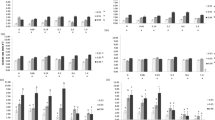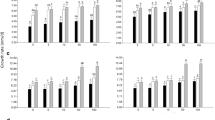Abstract
The combined effects of water activity (aw) and temperature on mycotoxin production by Penicilium commune (cyclopiazonic acid — CPA) and Aspergillus flavus (CPA and aflatoxins — AF) were studied on maize over a 14-day period using a statistical experimental design. Analysis of variance showed a highly significant interaction (P ≤ 0.001) between these factors and mycotoxin production. The minimum aw/temperature for CPA production (2264 ng g−1 P. commune, 709 ng g−1 A. flavus) was 0.90 aw/30 °C while greatest production (7678 ng g−1 P. commune, 1876 ng g−1 A. flavus) was produced at 0.98 aw/20 °C. Least AF (411 ng g−1) was produced at 0.90 aw/20 °C and most (3096 ng g−1) at 0.98 aw/30 °C.
Similar content being viewed by others
References
Dutton MF, Robertson EJ, Matthews C, Beck BDA. Occurrence of mycotoxins in maize in rural areas in South Africa and methods of prevention of contamination and elimination. In: Taylor JRN, Randall PG, Viljoen JH (eds), Cereal Science and Technology on a Changing Africa. Pretoria South Africa: CSIR, 1993: 823–835.
Hocking AD. Xerophillic fungi in intermediate and low moisture foods. In: Arora DK, Mukerji KG, Marth EH (eds), Handbook of Applied Mycology. vol 3. Foods and Feeds. New York, USA: Marcel Dekker, 1991: 69–97.
Ominski KH, Marquardt RR, Sinha RN, Abramson D. Ecological aspects of growth and mycotoxin production by storage fungi. In: Miller JD, Trenholm HL (eds), Mycotoxins in Grain: Compounds Other Than Aflatoxin. Minnesota, USA: Eagan Press, 1991; 287–312.
Chang-Yen I, Bidasee K. Improved spectrophotometric determination of cyclopiazonic acid in poultry feed. JAOAC 1990; 73: 257–259.
Norred WP. Cyclopiazonic acid: toxicity and tissue distribution. Vet Human Toxicol 1990; 20–26.
Norred WP, Porter JK, Dorner JW, Cole RJ. Occurrence of the mycotoxin cyclopiazonic acid in meat after oral administration to chickens. J Agric Food Chem 1988; 36: 113–116.
Dorner JW, Cole RJ, Erlington DJ, Suksupath S, McDowell GH, Bryden WL. Cyclopiazonic acid residues in ewe milk and chicken eggs. J Agri Food Chem 1994; 42: 1516–1518.
Frisvad JC, Filtenborg O. Terverticillate penicillia: chemotaxonomy and mycotoxin production. Mycologia 1989; 81: 837–861.
Hermansen K, Frisvad JC, Emborg C, Hansen J. Cyclopiazonic acid production by submerged cultures of Penicillium and Aspergillus strains. FEMS Microbiol Lett 1984; 21: 253–261.
Pitt JI, Leistner L. Toxigenic Penicillium species. In: Smith JE, Henderson RS (eds), Mycotoxins and Animal Foods. Boca Raton, USA: CRC Press, 1991; 81–100.
Frisvad JC. The connection between the penicillia and aspergilli and mycotoxins with special emphasis on misidentified isolates. Arch Environ Contam Toxicol 1989; 18: 452–467.
Pitt JI, Cruickshank RH, Leistner L. Penicillium commune, P. camembertii the origin of white cheese moulds and the production of cyclopiazonic acid. Food Microbiol 1986; 3: 363–371.
Lee YJ, Hagler Jr WM. Aflatoxin and cyclopiazonic acid production by Aspergillus flavus isolated from contaminated maize. J Food Sci 1991; 56: 871–872.
Trucksess MW, Misilevic PB, Young K, Bruce VR, Page SW. Cyclopiazonic acid production by cultures of Aspergillus flavus and Penicillium species isolated from dried beans, corn meal, macaroni and pecans. JAOAC 1987; 70: 123–126.
Urano T, Trucksess MW, Beaver BW, Wilson DM, Dorner JW, Dowell FE. Co-occurrence of cyclopiazonic acid and aflatoxins in corn and peanuts. JAOAC Int 1992; 75: 838–841.
Widiastuti R, Maryan R, Blaney BJ, Stoltz S, Stoltz DR. Cyclopiazonic acid in combination with aflatoxins zearalenone and ochratoxin A in Indonesian corn. Mycopathologia 1988; 104: 153–156.
CAST. Mycotoxins: Economics and Health Risks Council for Agricultural Science and Technology. Iowa, USA; Ames, 1989.
IARC. Some Naturally Occurring Substances: Food Items and Constituents. Heterocyclic Aromatic Amines and Mycotoxins. Vol 56. IARC Monographs on the Evaluation of Carcinogenic Risks to Humans: Lyon, France, 1993.
Dorner JW, Cole RJ, Diener UL. The relationship of Aspergillus flavus and Aspergillus parasiticus with references to production of aflatoxins and cyclopiazonic acid. Mycopathologia 1984; 87: 13–15.
Le Bars J. Cyclopiazonic acid production by Penicillium camembertii Thorn and natural occurrence of this mycotoxin in cheese. Appl Environ Microbiol 1979b; 38: 1052–1055.
Rao LB, Hussain A. Presence of cyclopiazonic acid in kodo millet (Paspalum scrobiculatum) causing ‘kodua poisoning’ in man and its production by associated fungi. Mycopathologia 1987; 89: 177–180.
Smith JE, Moss MO. Mycotoxins: Formation Analysis and Significance. Chichester, UK: John Wiley & Sons, 1985.
Richard JL, Peden WM, Thurston JR. Combined cyclopiazonic acid and aflatoxin B1 effects of serum bacteriostasis complement activity glycocholic acid and enzymes and histopathological changes in guinea pigs. In: Pohland AE, Dowell Jr VR, Richard JL (eds), Microbial Toxins in Foods and Feeds; Cellular and Molecular Modes of Action. New York, USA: Plenum, 1990; 411–419.
Frisvad JC, Samson RA. Filamentous fungi in foods and feeds: ecology spoilage and mycotoxin production. In: Arora DK, Mukerji KG, Marth EH (eds), Handbook of Applied Mycology. Vol 3. New York, USA: Marcel Dekker Inc, 1991; 32–68.
Lacey J. Prevention of mold growth and mycotoxin production through control of environmental factors. In: Natori S, Hashimoto K, Ueno Y (eds). Mycotoxins and Phycotoxins '88. Amsterdam, The Netherlands: Elsevier, 1989; 161–168.
Moss MO. The environmental factors controlling mycotoxin formation. In: Smith JE, Henderson RS. (eds), Mycotoxins and Animal Foods. Boca Raton, USA: CRC Press, 1991: 37–56.
Cuero RG, Smith JE, Lacey J. Interaction of water activity temperature and substrate on mycotoxin production by Aspergillus flavus, Penicillium viridicatum and Fusarium graminearum in irradiated grains. Trans Brit Mycol Soc 1987; 89: 221–226.
Cuero RG, Smith JE, Lacey J. Mycotoxin formation by Aspergillus flavus and Fusarium graminearum in irradiated maize grains in the presence of other fungi. J Food Prot 1988; 51: 452–456.
Faraj MK, Smith JE, Harran G. Interaction of water activity and temperature on aflatoxin production by Aspergillus flavus and A. parasiticus in irradiated maize seeds. Food Add Contam 1991; 8: 731–736.
Le Bars J. Cyclopiazonic acid bioproduction by Penicillium camemberti Thom: Effect of temperature on individual strains. Annal Rech Veterin 1979a; 10: 601–602.
Abramson D, Sinha RN, Mills JT. Mycotoxin formation in HY-320 wheat during granary storage at 15 and 19% moisture content. Mycopathologia 1990; 111: 181–189.
Ellis WO, Smith JP, Simpson BK, Ramaswamy H. Effect of inoculum level on aflatoxin production by Aspergillus flavus under modified atmosphere packaging (MAP) conditions. Food Microbiol 1993; 10: 525–535.
Sinha RN, Abramson D, Mills JT. Interrelations among ecological variables in stored cereals and associations with mycotoxin production in the climatic zones of Western Canada, J Food Prot 1986; 49: 608–614.
Box GEP, Hunter WG, Hunter JS. Statistics for Experimenters: An Introduction to Design Data Analysis and Model Building. Wiley and Sons: New York, USA, 1978.
Haltrich D, Laussamayer B, Steiner W. Xylanase formation by Sclerotium rolfsii: effect of growth substrates and development of a culture medium using statistically designed experiments. Appl Microbiol Biotech 1994; 42: 522–530.
Lewis CW, Smith JE, Anderson JG, Murad YM. The presence of mycotoxin-associated fungal spores isolated from the indoor air of the damp domestic environment and cytotoxic to human cell lines. Indoor Environ 1994; 3: 323–330.
Gervais P, Molin P, Grajek M, Bensoussan M. Influence of the water activity of a solid substrate on the growth rate and sporogenesis of filamentous fungi. Biotech Bioengin 1988; 31: 457–463.
Pixton SW, Warburton S. Moisture content/relative humidity equilibrium of some cereal grains to different temperatures. J Stored Prod Res 1971; 6: 283–293.
Cuero RG, Smith JE, Lacey J. A novel containment system for laboratory scale solid paniculate fermentations. Biotech Lett 1985; 7: 463–466.
Gorst-Allman CP, Steyn PS. Screening methods for the detection of thirteen common mycotoxins. J Chromat 1979; 175; 325–331.
Gimeno A. Thin layer chromatographic determination of aflatoxins, ochratoxins, sterigmatocystin, zearalenone, citrinin, T-2 toxin, diacetoxyscirpenol penicillic acid patulin and penitrem A. JAOAC 1979; 62: 579–585.
Trucksess MW, Stack ME, Nesheim S, Page SW, Albert RH, Hansen TJ, Donahue KF. Immunoaffinity column coupled with solution fluorometry or liquid chromatography postcolumn derivatization for determination of aflatoxins in corn peanuts and peanut butter: collaborative study. JAOAC 1991; 74: 81–88.
Magan N, Lacey J. Effect of water activity and temperature on mycotoxin production by Alternaria alternata in culture and on wheat grain. Appl Environ Microbiol 1984; 47: 1113–1117.
Wagener RE, Davies ND, Diener UL. Penitrem A and roquefortine production Penicillium commune. Appl Environ Microbiol 1980; 39: 882–887.
Miller JD. Fungi and mycotoxins in grain: implication for stored product research. J Stored Prod Res 1995; 31: 1–16.
Author information
Authors and Affiliations
Corresponding author
Rights and permissions
About this article
Cite this article
Gqaleni, N., Smith, J.E., Lacey, J. et al. The production of cyclopiazonic acid by Penicillium commune and cyclopiazonic acid and aflatoxins by Aspergillus flavus as affected by water activity and temperature on maize grains. Mycopathologia 136, 103–108 (1996). https://doi.org/10.1007/BF00437503
Received:
Accepted:
Issue Date:
DOI: https://doi.org/10.1007/BF00437503




